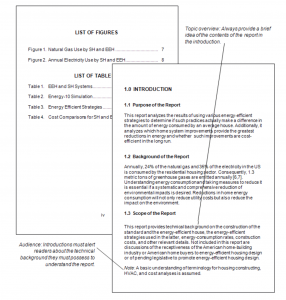6.5: Formal Report—Introduction and Discussion
Learning Objectives
- Determine the parts of a formal report’s introduction and discussion
What Is a Formal Report Introduction?
An essential element of any report is its introduction; this section makes sure the reader is clear on the report’s purpose and contents. In a technical report, the introduction prepares the reader to read the main body of the report. The introduction sets the stage for the report, clarifies what need(s) motivated it, and helps the reader understand what structure the report will follow.
The introductions to your technology report should address the following elements: background information, problem, purpose, and scope. As you may have noticed, some parts of a formal report fulfill similar purposes. Information from the cover letter and the summary/abstract may be repeated in the introduction. Reword the information in order to avoid sounding repetitive.
According to Blicq and Moretto (2012), “The length of the introduction and its depth of detail depend mostly on how well you understand your readers’s knowledge of the topic” (p. 96).
Example: Introduction

b. What problem is addressed in the report? (Problem)
c. Why was the work described in the Technology Report undertaken? (Purpose)
d. What is included and/or omitted? What are the limitations that impacted the report (e.g., time, access to equipment, etc)? (Scope)
What Is a Formal Report Discussion?
The formal report discussion presents, interprets and analyzes the evidence, preparing your reader for your conclusions. This key section of the report should be carefully organized to enhance readability. According to Blicq and Moretto (2012), “The discussion is the longest part of a report, and so presents all the evidence (facts, arguments, details, data, and results of tests) that readers need to understand the subject” (p. 98).
Since the discussion is the longest section of the report, it will be important to use headings and lists to help make it easy to navigate for your readers. For tips on headings see 2.3: Choosing Headings and for tips on lists see 2.4: Creating Lists.
According to OACETT’s “Technology Report Guidelines” (2021), if you are sharing the results of lab work, this section of the report should include methodology, results, data, and analysis (p. 7). The methodology describes any steps that were taken to address the problem that is the focus of the report. The results, data, and analysis sections share and interpret your findings. You should use the subheadings “Methodology,” “Results,” “Data,” and “Analysis” to sub-divide the Discussion section.
As you present, interpret, and analyze evidence, you should consider using both text and graphics. For details on creating graphics, see Chapter 9: Using Graphics in Reports. Always use your understanding of your audience and purpose to inform your decisions about use of graphics.
Include citations for all quoted or paraphrased material from sources as well; in ENGL 250, use APA-style rules for all citations.
Blicq and Moretto (2012) recommend a number of options for organizing the report discussion:
by chronological development—in which you present information in the sequence that the events occurred.
by subject development—in which you arrange information by subjects, grouped in a predetermined order.
by concept development—in which you organize information by concepts, presenting it as a series of ideas that imaginatively and coherently reveal how you reasoned your way to a logical conclusion. (p. 98)
References & Attributions
References
Blicq, R., & Moretto, L. (2012). Technically write. (8th Canadian Ed.). Pearson Canada.
OACETT. (2021). Technology report guidelines. https://www.oacett.org/getmedia/9f9623ac-73ab-4f99-acca-0d78dee161ab/TR_GUIDELINES_Final.pdf.aspx
Attributions
Content is adapted from Technical Writing by Allison Gross, Annemarie Hamlin, Billy Merck, Chris Rubio, Jodi Naas, Megan Savage, and Michele DeSilva, which is is licensed under a Creative Commons Attribution-NonCommercial-ShareAlike 4.0 International License, except where otherwise noted.
Content is adapted from Writing Formal Reports by Melissa Ashman; Arley Cruthers; eCampusOntario; Ontario Business Faculty; and University of Minnesota, which is licensed under a Creative Commons Attribution-NonCommercial 4.0 International License, except where otherwise noted.

